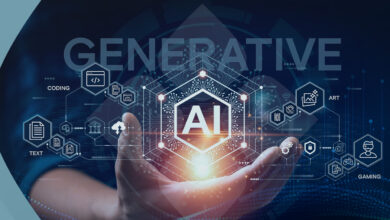6 generative AI areas of action for educators (opinion)

In the swiftly evolving landscape of higher education, the emergence of generative artificial intelligence (GenAI) presents an unprecedented opportunity. Unlike previous technological advancements that often required educators to passively adapt to ready-made software, GenAI invites proactive engagement, offering a canvas for innovation and creativity. This shift is not merely technical but philosophical, challenging us to reimagine our roles not as consumers of technology but as creators and collaborators.
GenAI can democratize education, tailor learning experiences to individual needs and bridge disparity gaps, giving it potential as an immense and versatile student success tool. But educators must take the helm of research and development, steering the integration of AI with intention and expertise. Following are six areas around which to focus action.
1. Leveraging Your Expertise
The first step in embracing GenAI is leveraging the deep well of faculty expertise. We are not just content experts but architects of learning experiences, with a nuanced understanding of pedagogy that AI cannot simply replicate. However, preparing and implementing pedagogical concepts, frameworks and techniques can be very time-consuming. The reality is that most faculty are often saddled with many responsibilities including service and research and do not have the resources and time to transfer pedagogy systematically throughout their teaching repertoire.
Led by pedagogical expertise, educators can now guide Large Language Models (LLMs) to create materials that resonate with disciplinary intricacies, reflect diverse perspectives and engage students in meaningful ways while assessing the most effective practices. Moving from concept to practice can be done with ease and timeliness. This collaboration between human and artificial intelligence stands to elevate the quality of education, making it more accessible, effective and impactful.
Idea in Action: A key focus in my first-year seminar is on self-awareness of psychological factors, such as motivation, being vital to college success. Students often confuse critical motivational theories, simplifying diverse concepts into mere “positive thinking.” This oversimplification can diminish the ability to articulate challenging experiences and arrive at new ones, thereby affecting overall success. Utilizing interactive LLMs to analyze scenarios can help them distinguish these motivational concepts. By prompting students to articulate these differences through personalized examples, they can develop a more nuanced understanding and better reflect on their experiences, enhancing their academic engagement and success.
2. Learning and Practicing Prompting
Effective interaction with GenAI requires a new skill set, particularly around prompting, yet through the familiarity of natural language. Crafting prompts that elicit useful, accurate and pedagogically sound responses from LLMs is both methodical and constantly evolving. Through consistent practice, educators can become fluent in the general rules and idiosyncrasies of this new language, experimenting with and refining their approaches to ensure that AI tools serve their educational objectives.
This process is not about mastering a static set of commands but about engaging in an ongoing dialogue while learning to navigate LLM capabilities and limitations to enhance teaching and learning. It is about figuring out what LLMs are good at, particularly within our unique disciplines, and identifying the most pressing challenges for us and our students to solve. Faculty can develop prompt libraries within their subjects and specializations that can be tailored to a variety of needs and courses and shared for more cohesive teaching and learning approaches.
Idea in Action: In my experience, creating a series of iterative prompts that provide a goal and guide the LLM through a thought process step-by-step (Chain of Thought/Thread of Thought) can significantly enhance its utility. I have found that asking LLMs to outline a complex concept gradually, breaking tasks into chunks or augmenting its response by feeding it additional documents for increased “attention” can make it more accurate and useful. It seems to even respond to “pep talks” when it is struggling with certain tasks. By continually refining these techniques, we can turn GenAI from a novel gadget to a powerful thought partner with relative consistency.
3. Moving Beyond “Boxed” Tech Mindsets
Traditionally, technology in education has been characterized by a “boxed” mindset, where software comes with predetermined functions and limited scope for customization. GenAI shatters this paradigm, offering educators the tools to build their own libraries of content and resources tailored to their specific discipline needs. This shift in creative power allows educators to move beyond the constraints of off-the-shelf software. Most importantly, it presents an opportunity for a highly autonomous approach to technology use in education that is unprecedented, given the power of LLMs and the current decentralized situation. Lastly, GenAI tools cut through the typical time in learning the “technology” while producing meaningful outputs in seconds, rather than hours or days!
Idea in Action: The flexibility of GenAI allows for the creation of customized teaching tools easily adapted to changing demands. I have created interactive LLM prompts and custom chatbots (GPTs) to reinforce teaching content aligned with the varying needs of my students across different classes using appropriate assessment and feedback. These capabilities have transformed my approach to using technology in education, enabling me to craft learning experiences that are deeply contextualized and responsive. I can now use GenAI tools to enhance and individualize the educational process, making it a multidimensional resource that supports a wide range of objectives in a fraction of the time.
4. Considering Ethics and Future Preparation
As we integrate GenAI into education, ethical considerations must be at the forefront. While there are many concerns surrounding writing integrity, copyright infringement and privacy, we should adopt a balanced view including our ethical obligations as educators.
Albert Camus is said to have stated, “School prepares us for the life in the world that does not exist.” Today, we are preparing students for a future where AI will likely play a significant role in every aspect of life, while transforming careers requiring high levels of education in white collar fields. Our responsibility is to ensure that this preparation includes a critical understanding of AI’s ethical dimensions, fostering a generation of learners who are not only technologically proficient but also capable of functioning within it. This is crucial when we consider our work in higher education as aimed at increasing social mobility and mitigating disparities. For these reasons, and more, higher education faculty must be at the forefront of preparing students for an AI-filled future.
Idea in Action: At public, comprehensive universities serving diverse populations, embedding AI literacy into the curriculum from the first year can have a transformative impact. By aligning AI fundamentals with career skills, often introduced in first-year seminars, we can lay a foundation for equitable tech access. Discipline-specific faculty can also extend features across all degree plans, guaranteeing that every student, regardless of their major or background, graduates with AI proficiency. This not only levels the playing field in the job market but also prepares students to ethically and effectively engage with AI in their future careers. A comprehensive integration can help reduce the digital divide and ensure our graduates are both capable of competing with their AI-proficient peers and prepared to lead in an AI-driven world.
5. Knowing Your “Personnel”
Recognizing and leveraging GenAI’s strengths and limitations is crucial for educators to enhance learning while mitigating risks. GenAI’s ability to translate concepts into practice, streamline complex processes and provide personalized feedback can significantly improve classroom efficiency and reduce educators’ workloads. By incorporating these strengths into the curriculum, faculty can foster a more engaging and tailored learning experience.
However, GenAI’s limitations, such as its propensity for errors and dependence on precise instructions and pretrained data, necessitate a mindful approach to integration. Addressing these challenges head-on, educators can guide students toward informed and critical use of GenAI tools, preventing misuse and the pitfalls of passive learning while leveraging its weaknesses. Explicitly outlining GenAI’s capabilities and limitations empowers students to navigate these tools effectively, preserving active engagement and collaborative learning. This balanced approach ensures that GenAI promotes efficiency while safeguarding the quality of learning and intellectual development.
Idea in Action: Utilize a “teaching” syllabus outline that demonstrates the strengths and weaknesses of AI within the educational process rather than a prescriptive paragraph to be read and forgotten. On day one, these aspects can be discussed with time for first-order and second-order thinking followed by practical applications. For instance, since LLMs sometimes “hallucinate” or generate misleading information, they are best utilized within areas in which we have some prior knowledge and can verify. One approach is substantiating AI-generated information against class notes, readings and lectures—teaching students to treat AI as a tool to augment learning, not as a substitute for thinking. Students learn to leverage AI’s capabilities responsibly, applying it to complement their coursework while critically assessing its accuracy and relevance. This method builds better self-regulation, equipping students with the skills to use AI effectively and ethically in their academic and future professional lives.
6. Building in the Human Loop
A 2005 PBS interview with Kurt Vonnegut provides insight into why he refused to order envelopes online and instead preferred going to the store where he would see and meet people in the process. He said, “What the computer people don’t realize, or they don’t care, is we’re dancing animals. You know, we love to move around. And it’s like we’re not supposed to dance at all anymore.”
This poetic reflection on human nature underscores the importance of maintaining the human element in education. Integrating GenAI tools into teaching and learning does not mean replacing the human touch with cold algorithms and endless prompts. Instead, it’s about augmenting human interaction, enhancing the educator’s role, reducing the challenges of feedback, implementing high engagement grounded in sound pedagogy and enriching learning experiences with critical thinking and guidance in a personalized manner. Intentionally building the human loop into lessons ensures that education remains a deeply personal, empathetic and thoughtful experience along a potentially transformative journey.
Idea in Action: I developed the “HumanAIzing Learning Cycle” to map a complete AI-integrated lesson rooted in two key principles: first, faculty-designated conceptual frameworks guide the integration of GenAI, not the reverse; second, the social and communal aspects of teaching and learning are preserved, even as AI components are incorporated. The cycle begins with a pedagogically driven lesson plan, followed by topic-specific student prompts that engage with GenAI’s iterative capabilities. Students then evaluate AI-generated content against trusted sources, leading to phases of reflection, engagement and assessment, culminating in feedback. The cycle prevents the passive use of GenAI and makes the educational experience more interactive and responsive. It is a blueprint for educators looking to incorporate GenAI into their teaching practices thoughtfully with valued teaching methods, ensuring technology enhances rather than diminishes quality.
The Broader Goal: Embrace GenAI With Vision and Responsibility
Educators have the unique opportunity to harness GenAI’s transformative potential—turning concepts into engaging classroom practices, personalizing the learning journey and streamlining educational processes. Yet, this technological frontier demands more than just adaptation; it calls for a reimagining of our pedagogical paradigms and an understanding that we are not being replaced but needed more than ever. By integrating GenAI’s strengths into our curricula in small ways, we can craft a more interactive, efficient and democratizing educational experience.
This is a call to action for educators to lead with creativity, courage and a deep commitment to transformative education. Let us seize this moment to meaningfully redefine the landscape of higher education, making it a beacon of innovation and inclusivity that has evaded us in the past.



